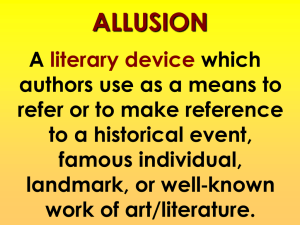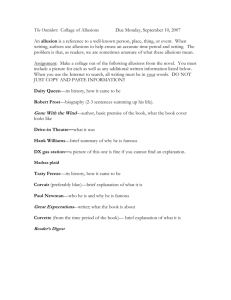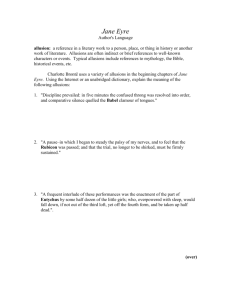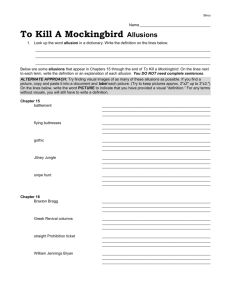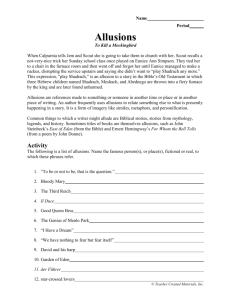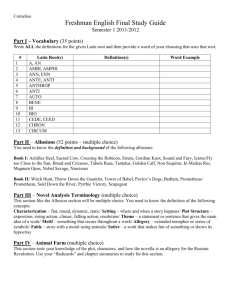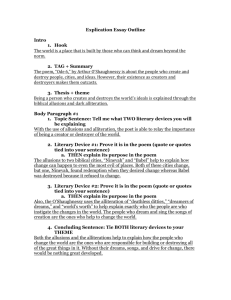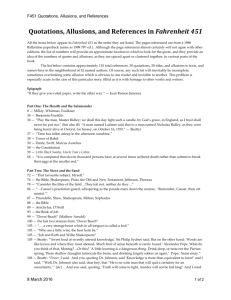2015 AP English Literature
advertisement
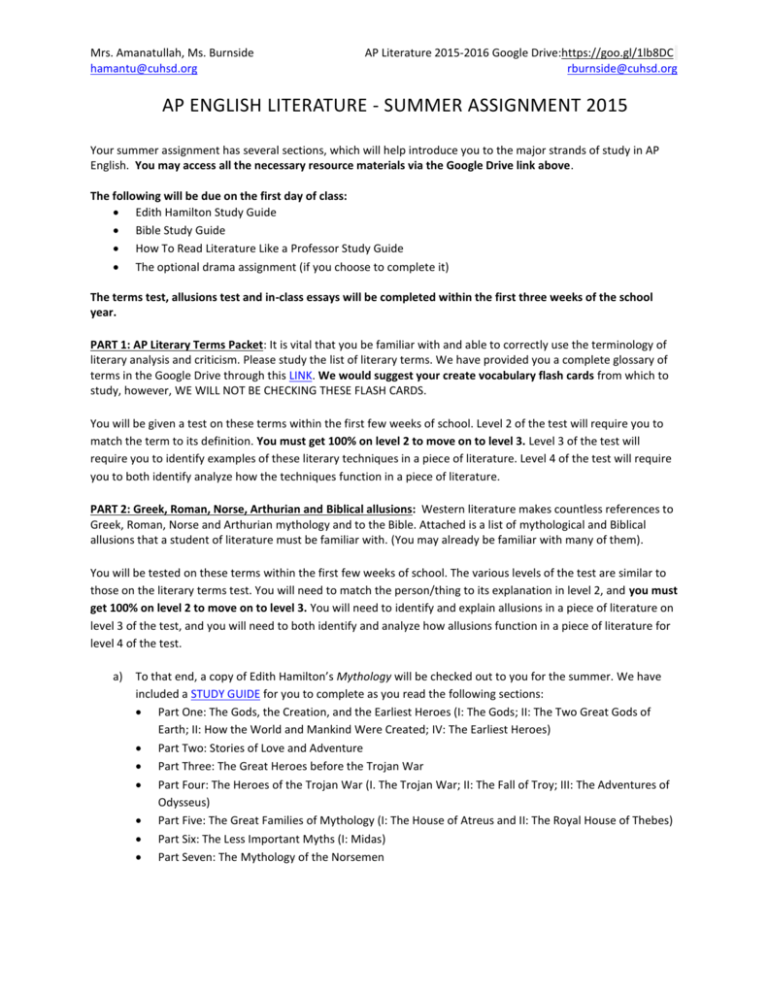
Mrs. Amanatullah, Ms. Burnside hamantu@cuhsd.org AP Literature 2015-2016 Google Drive:https://goo.gl/1lb8DC rburnside@cuhsd.org AP ENGLISH LITERATURE - SUMMER ASSIGNMENT 2015 Your summer assignment has several sections, which will help introduce you to the major strands of study in AP English. You may access all the necessary resource materials via the Google Drive link above. The following will be due on the first day of class: Edith Hamilton Study Guide Bible Study Guide How To Read Literature Like a Professor Study Guide The optional drama assignment (if you choose to complete it) The terms test, allusions test and in-class essays will be completed within the first three weeks of the school year. PART 1: AP Literary Terms Packet: It is vital that you be familiar with and able to correctly use the terminology of literary analysis and criticism. Please study the list of literary terms. We have provided you a complete glossary of terms in the Google Drive through this LINK. We would suggest your create vocabulary flash cards from which to study, however, WE WILL NOT BE CHECKING THESE FLASH CARDS. You will be given a test on these terms within the first few weeks of school. Level 2 of the test will require you to match the term to its definition. You must get 100% on level 2 to move on to level 3. Level 3 of the test will require you to identify examples of these literary techniques in a piece of literature. Level 4 of the test will require you to both identify analyze how the techniques function in a piece of literature. PART 2: Greek, Roman, Norse, Arthurian and Biblical allusions: Western literature makes countless references to Greek, Roman, Norse and Arthurian mythology and to the Bible. Attached is a list of mythological and Biblical allusions that a student of literature must be familiar with. (You may already be familiar with many of them). You will be tested on these terms within the first few weeks of school. The various levels of the test are similar to those on the literary terms test. You will need to match the person/thing to its explanation in level 2, and you must get 100% on level 2 to move on to level 3. You will need to identify and explain allusions in a piece of literature on level 3 of the test, and you will need to both identify and analyze how allusions function in a piece of literature for level 4 of the test. a) To that end, a copy of Edith Hamilton’s Mythology will be checked out to you for the summer. We have included a STUDY GUIDE for you to complete as you read the following sections: Part One: The Gods, the Creation, and the Earliest Heroes (I: The Gods; II: The Two Great Gods of Earth; II: How the World and Mankind Were Created; IV: The Earliest Heroes) Part Two: Stories of Love and Adventure Part Three: The Great Heroes before the Trojan War Part Four: The Heroes of the Trojan War (I. The Trojan War; II: The Fall of Troy; III: The Adventures of Odysseus) Part Five: The Great Families of Mythology (I: The House of Atreus and II: The Royal House of Thebes) Part Six: The Less Important Myths (I: Midas) Part Seven: The Mythology of the Norsemen Mrs. Amanatullah, Ms. Burnside hamantu@cuhsd.org AP Literature 2015-2016 Google Drive:https://goo.gl/1lb8DC rburnside@cuhsd.org b) We also suggest that you read the following sections of the Bible. We’ve put together a STUDY GUIDE to assist you. Genesis Job Exodus The Gospel of Matthew Psalms 22, 23, 95, 121 The Gospel of Mark PART 3: How to Read Literature Like a Professor: You can access an electronic copy of this book at the following link: https://goo.gl/w4pKHw. You will be responsible for reading How to Read Literature Like a Professor in its entirety. We have created a STUDY GUIDE for you to complete. We also strongly suggest you take detailed notes on the book, and have provided you with a note-taking graphic to assist you, which you can find here. We will not be checking those notes, however, you will be able to use any notes you take when you write an essay during the first two weeks of school applying the techniques from HTRLLAP to the analysis of a short piece of fiction. Optional Assignment -- Drama Review: You will undoubtedly find it helpful to attend a theater production of a Shakespearean play. I recommend the productions of the Los Gatos Shakespeare Festival, Shakespeare Play On in Santa Cruz, Silicon Valley Shakespeare, the California Shakespeare Festival in Orinda, or “Free Shakespeare in the Park,” sponsored by the San Francisco Shakespeare Festival. Among the offerings this year are The Tempest, The Comedy of Errors, Romeo and Juliet, Antony and Cleopatra, Pericles, Macbeth, Much Ado about Nothing, Twelfth Night and King Lear. Perhaps some of you can attend the play together so you can enjoy it together and discuss it. Following the performance, you should write a complete play review, typed and in MLA format, that will be added to your grade as a non-required assignment. Submit your review to Turnitin.com. Use the following information to submit your paper. Class ID number: 9972166 Password: burnside Google Drive: We have created a 2015-2016 AP Literature Class folder on Google Drive. You can access the folder with this link: https://goo.gl/1lb8DC. We will periodically add information, documents to this folder. You can also add things that you think your fellow students will find helpful. Mythological and Biblical Allusions List You will be responsible for knowing the following allusions from Classical or Biblical literature: Arthurian Allusions Guinevere The Holy Grail Biblical Allusions 10 Plagues of Egypt Abram/Abraham Adam Ararat Ark of the Covenant Barabbas Bethlehem King Arthur Lancelot Tristan and Isolde Cain and Abel Caiaphas Canaan Crown of thorns Eden Eve Four Horsemen of the Apocalypse Garden of Gethsemane Gold, Frankincense, Myrrh The Golden Calf Golgotha Goliath Mrs. Amanatullah, Ms. Burnside hamantu@cuhsd.org AP Literature 2015-2016 Google Drive:https://goo.gl/1lb8DC rburnside@cuhsd.org Hagar Harrowing of Hell Herod Isaac, Rebekah and Leah Jacob and Esau Job John the Baptist Joseph, son of Jacob Joseph of Nazareth Judas King David Last Supper Lazarus Leah and Rachel Manna Moses Mt. Ararat Nephilim Noah and the Ark Nod/East of Eden Pharisees and Sadducees Pontius Pilate Potiphar’s wife Saint Paul/Saul Saint Peter/Simon Salome Samson and Delilah Sarai/Sarah Sermon on the Mount Serpent Simon Magus Sodom and Gomorrah Solomon Susannah and the Elders Thirty pieces of silver Three Wisemen/Magi Tower of Babel Twelve Apostles The Virgin Mary Greek/Roman Allusions Acheron Achilles Adonis Aeneas Aeolus Agamemnon Ajax Antigone Aphrodite/Venus Apollo Ares/Mars Argus Aristotle Artemis/Diana Athena/Minerva Atlas Brutus and Cassius Cadmus Calypso Capaneus Carthage Castor and Pollux Centaurs Cerberus Charon Circe Cleopatra Clytemnestra Cronus/Saturn The Cyclops Polythemus Daedalus Demeter/Ceres Dido Diomedes Dionysus/Bacchus Electra Epicurus Eros/Cupid Eteocles and Polyneices Europa The Fates/Moirae/Parcae Fortuna Furies Hades/Pluto Harpies Hector Hecuba Helen Helios Hephaestus/Vulcan Hera/Juno Hercules Hermes/Mercury Hestia/Vesta Hyperion Icarus Iphigenia Ios Ithaca Janus Jason and the Argonauts Lares and Penates Leda Lethe Medea Medusa and the Gorgons Menelaus Midas Minotaur Mnemosyne The Muses Narcissus Niobe Odysseus/Ulysses Oedipus Orestes Orpheus and Eurydice Pan and the Satyrs/Fauns Pandora Paris Patroclus Penelope Persephone/Proserpina Perseus Phaëthon Poseidon/Neptune Priam Prometheus Psyche Pygmalion and Galatea Pyramus and Thisbe Pyrrhus/Neoptolemus Remus Romulus/Quirinus Scylla and Charybdis Selene/Luna Semiramis Sirens Sisyphus Styx Telemachus Thebes Theseus Tantalus Thetis Tiresias Troy Zeus/Jupiter Mrs. Amanatullah, Ms. Burnside hamantu@cuhsd.org Norse Allusions Aesir Asgard Balder Brynhild Freya Frigga Gudrun AP Literature 2015-2016 Google Drive:https://goo.gl/1lb8DC rburnside@cuhsd.org Hugin and Munin Loki Midgard Niflheim Odin Ragnarök Sigurd Thor Tyr Valhalla Valkyrie Yggdrasil AP LITERARY TERMS You will be responsible for knowing the following literary terms. Many of them should already be familiar to you. Although we will not be collecting your flash cards, you will be held accountable for studying through a literary terms test in the first few weeks of school. Accent/beat Allegory Alliteration Allusion Ambiguity Analogy Anaphora Anastrophe Anecdote Antagonist Anticlimax Antihero Antithesis Aphorism Apostrophe Apposition Archetype Aside Assonance Asyndeton Aubade Ballad Bathos Black humor Blank verse Cacophony Cadence Canto Caricature Catharsis Characterization Indirect characterization Direct characterization Static character Dynamic character Flat character Round character Chiasmus Chorus Cliché Colloquialism Comedy Conceit Conflict External conflict Internal conflict Connotation Consonance Couplet Denotation Deus ex machina Dialect Diction Didactic Dirge Dissonance Elegy Enjambment Epic Epigraph Epistrophe Epithet Euphemism Euphony Explication Exposition Fable Farce Feminine rhyme Figurative language Flashback Foil Foot Foreshadowing Free verse Genre Heroic couplet Hubris Hyperbole Imagery In medias res Interior monologue Internal rhyme Inversion Irony Verbal irony Dramatic irony Situational irony Cosmic irony Juxtaposition Kenning Litotes Local color Loose sentence Lyric poem Masculine rhyme Metaphor Implied metaphor Extended metaphor Dead metaphor Mixed metaphor Mrs. Amanatullah, Ms. Burnside hamantu@cuhsd.org AP Literature 2015-2016 Google Drive:https://goo.gl/1lb8DC rburnside@cuhsd.org Meter: Anapestic meter Dactylic meter Iambic meter Spondaic meter Trochaic meter Plot Exposition Rising action Climax Falling action Resolution Metonymy Mood Motif Motivation Narration/ narrative verse Frame narrative Nemesis Objectivity Onomatopoeia Oxymoron Parable Paradox Parallel structure (parallelism) Parenthetical phrase Parody Pastoral poetry Pathos Periodic sentence Persona Personification Point of view First person point of view Third person point of view Omniscient point of view Objective point of view Second person Impressionism Modernism Naturalism Plain style Polysyndeton Protagonist Pun Pyrrhic meter Quatrain Refrain Requiem Rhythm Rhetoric Rhetorical question Romance Satire Writing movements and styles to know: Rationalism Realism Regionalism Romanticism Formal or direct satire Horatian Juvenalian Setting Simile Soliloquy Stanza Stock character Stream of consciousness Style Suspense Suspension of disbelief Symbol Synecdoche Tall tale Theme Thesis Tone Tragedy Tragic flaw Tragic irony Understatement Utopia Vernacular Surrealism Symbolism Transcendentalism
